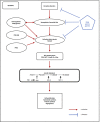Thermodynamics in Gliomas: Interactions between the Canonical WNT/Beta-Catenin Pathway and PPAR Gamma
- PMID: 28620312
- PMCID: PMC5451860
- DOI: 10.3389/fphys.2017.00352
Thermodynamics in Gliomas: Interactions between the Canonical WNT/Beta-Catenin Pathway and PPAR Gamma
Abstract
Gliomas cells are the site of numerous metabolic and thermodynamics abnormalities with an increasing entropy rate which is characteristic of irreversible processes driven by changes in Gibbs energy, heat production, intracellular acidity, membrane potential gradient, and ionic conductance. We focus our review on the opposing interactions observed in glioma between the canonical WNT/beta-catenin pathway and PPAR gamma and their metabolic and thermodynamic implications. In gliomas, WNT/beta-catenin pathway is upregulated while PPAR gamma is downregulated. Upregulation of WNT/beta-catenin signaling induces changes in key metabolic enzyme that modify their thermodynamics behavior. This leads to activation pyruvate dehydrogenase kinase 1(PDK-1) and monocarboxylate lactate transporter 1 (MCT-1). Consequently, phosphorylation of PDK-1 inhibits pyruvate dehydrogenase complex (PDH). Thus, a large part of pyruvate cannot be converted into acetyl-CoA in mitochondria and in TCA (tricarboxylic acid) cycle. This leads to aerobic glycolysis despite the availability of oxygen, named Warburg effect. Cytoplasmic pyruvate is, in major part, converted into lactate. The WNT/beta-catenin pathway induces also the transcription of genes involved in cell proliferation, cell invasiveness, nucleotide synthesis, tumor growth, and angiogenesis, such as c-Myc, cyclin D1, PDK. In addition, in gliomas cells, PPAR gamma is downregulated, leading to a decrease in insulin sensitivity and an increase in neuroinflammation. Moreover, PPAR gamma contributes to regulate some key circadian genes. Abnormalities in the regulation of circadian rhythms and dysregulation in circadian clock genes are observed in gliomas. Circadian rhythms are dissipative structures, which play a key role in far-from-equilibrium thermodynamics through their interactions with WNT/beta-catenin pathway and PPAR gamma. In gliomas, metabolism, thermodynamics, and circadian rhythms are tightly interrelated.
Keywords: PI3K-Akt pathway; PPAR gamma; WNT/beta-catenin pathway; Warburg effect; aerobic glycolysis; circadian rhythms; gliomas; lactate.
Figures


Similar articles
-
Thermodynamics in cancers: opposing interactions between PPAR gamma and the canonical WNT/beta-catenin pathway.Clin Transl Med. 2017 Dec;6(1):14. doi: 10.1186/s40169-017-0144-7. Epub 2017 Apr 12. Clin Transl Med. 2017. PMID: 28405929 Free PMC article. Review.
-
Thermodynamics in Neurodegenerative Diseases: Interplay Between Canonical WNT/Beta-Catenin Pathway-PPAR Gamma, Energy Metabolism and Circadian Rhythms.Neuromolecular Med. 2018 Jun;20(2):174-204. doi: 10.1007/s12017-018-8486-x. Epub 2018 Mar 23. Neuromolecular Med. 2018. PMID: 29572723 Review.
-
Demyelination in Multiple Sclerosis: Reprogramming Energy Metabolism and Potential PPARγ Agonist Treatment Approaches.Int J Mol Sci. 2018 Apr 16;19(4):1212. doi: 10.3390/ijms19041212. Int J Mol Sci. 2018. PMID: 29659554 Free PMC article. Review.
-
Reprogramming energetic metabolism in Alzheimer's disease.Life Sci. 2018 Jan 15;193:141-152. doi: 10.1016/j.lfs.2017.10.033. Epub 2017 Oct 25. Life Sci. 2018. PMID: 29079469 Review.
-
Aerobic Glycolysis Hypothesis Through WNT/Beta-Catenin Pathway in Exudative Age-Related Macular Degeneration.J Mol Neurosci. 2017 Aug;62(3-4):368-379. doi: 10.1007/s12031-017-0947-4. Epub 2017 Jul 8. J Mol Neurosci. 2017. PMID: 28689265 Review.
Cited by
-
Potential role of cannabidiol in Parkinson's disease by targeting the WNT/β-catenin pathway, oxidative stress and inflammation.Aging (Albany NY). 2021 Apr 13;13(7):10796-10813. doi: 10.18632/aging.202951. Epub 2021 Apr 13. Aging (Albany NY). 2021. PMID: 33848261 Free PMC article. Review.
-
Identification of KIF23 as a Prognostic Biomarker Associated With Progression of Clear Cell Renal Cell Carcinoma.Front Cell Dev Biol. 2022 Apr 11;10:839821. doi: 10.3389/fcell.2022.839821. eCollection 2022. Front Cell Dev Biol. 2022. PMID: 35478956 Free PMC article.
-
Interplay between the renin-angiotensin system, the canonical WNT/β-catenin pathway and PPARγ in hypertension.Curr Hypertens Rep. 2018 Jun 9;20(7):62. doi: 10.1007/s11906-018-0860-4. Curr Hypertens Rep. 2018. PMID: 29884931 Review.
-
Targeting the Canonical WNT/β-Catenin Pathway in Cancer Treatment Using Non-Steroidal Anti-Inflammatory Drugs.Cells. 2019 Jul 15;8(7):726. doi: 10.3390/cells8070726. Cells. 2019. PMID: 31311204 Free PMC article. Review.
-
Metabolic reprogramming and renal fibrosis: what role might Chinese medicine play?Chin Med. 2024 Oct 28;19(1):148. doi: 10.1186/s13020-024-01004-x. Chin Med. 2024. PMID: 39465434 Free PMC article. Review.
References
Publication types
LinkOut - more resources
Full Text Sources
Other Literature Sources
Research Materials
Miscellaneous

